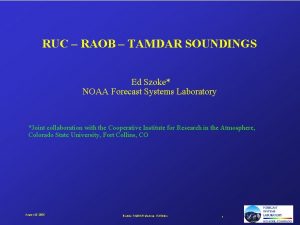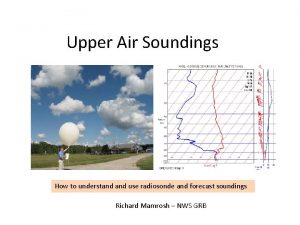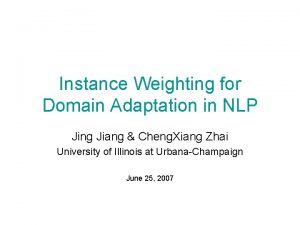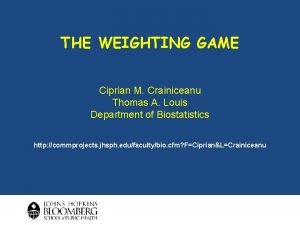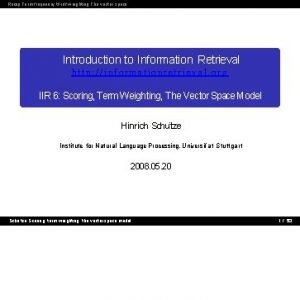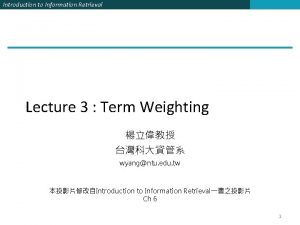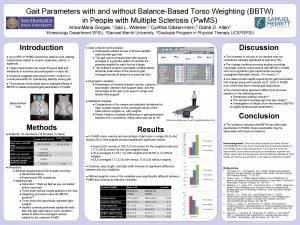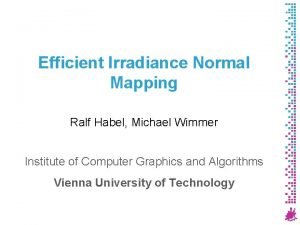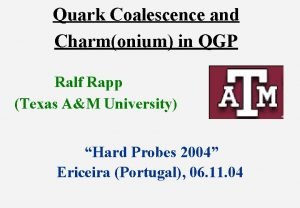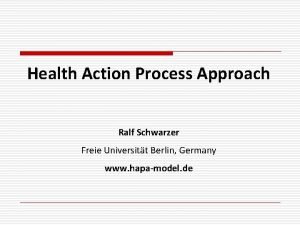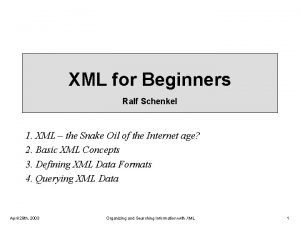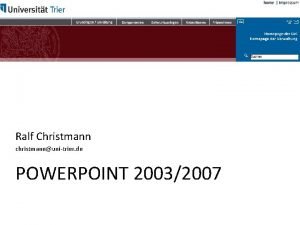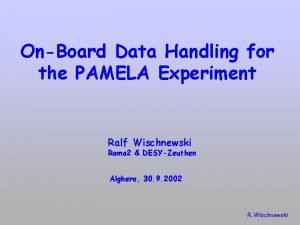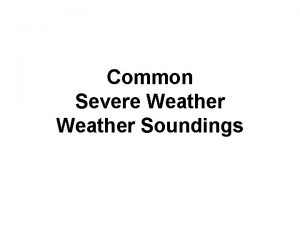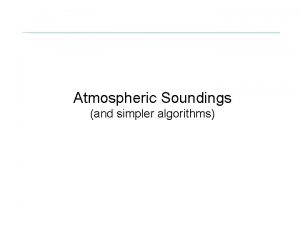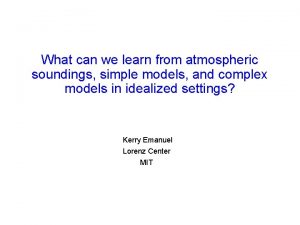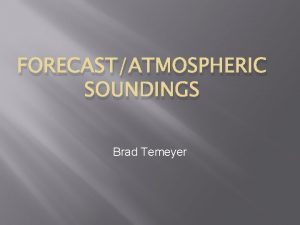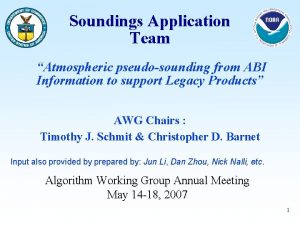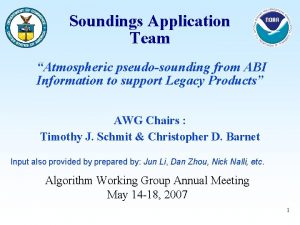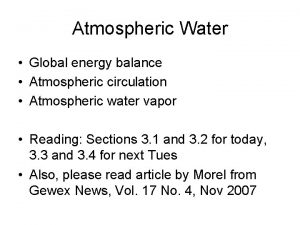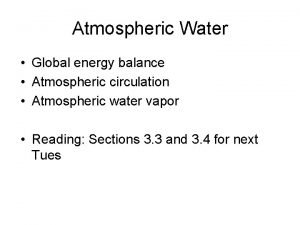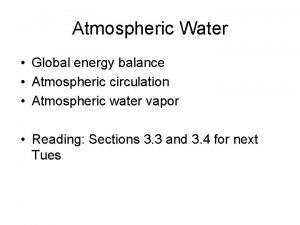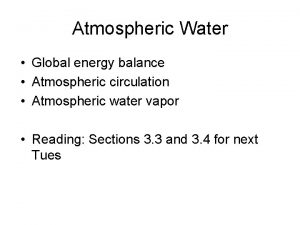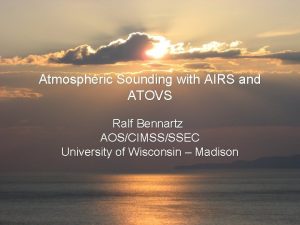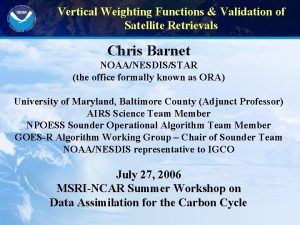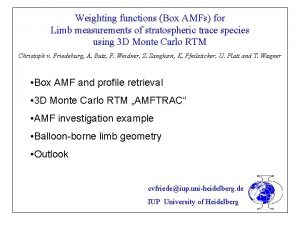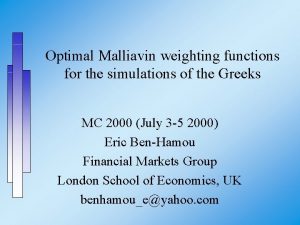Weighting Functions and Atmospheric Soundings Part I Ralf




















- Slides: 20


Weighting Functions and Atmospheric Soundings: Part I Ralf Bennartz Cooperative Institute for Meteorological Satellite Studies University of Wisconsin – Madison

Outline • What we want to know and why we need it? • What does a satellite really observe (a. k. a. The radiative transfer equation) • Weighting functions • Recap: What is important?

What do we want to know? • Weather forecasting? What data is needed for NWP model initialization (assimilation)? Source: Kelly and Thepaut, 2007 ECMWF Newsletter 113

Why are satellite data important forecasts? • Forecast skill strongly dependent on satellite data • E. g. Southern hemisphere: Day 3 -4 forecasts now as good as Day 1 forecasts without satellite data. Source: Kelly and Thepaut, 2007 ECMWF Newsletter 113

What does a satellite observe? • Detects number of photons per exposure time at a given wavelength (or wvl range)traveling from viewing direction into detector • No. of photons, direction, per time RADIANCE • We need to physically and quantitatively understand the relation between observed radiance and state of the atmosphere • Radiative Transfer Equation

What can happen to photons? • 1. Photons can be ABSORBED • 2. Photons can be EMITTED • 3. Photons can be SCATTERED Let’s now build a budget equation for a beam of photons I(θ, ϕ) traveling in a certain direction (θ, ϕ): Done…. . Theoretical physics is so great…

Unfortunately, we need a bit more detail… Sink I: Absorption Proportional to how many photons are traveling in the first place (I) Proportional to how effectively the medium absorbs radiation, let’s call this proportionality constant the volume absorption coefficient (βA) Beer’s Law (exponential decay)

Unfortunately, we need a bit more detail… Source I: Emission Proportional to Planck function of medium (gas) at temperature T Proportional to how effectively the medium emits radiation If the medium is in local thermodynamic equilibrium this is also described by to the volume absorption coefficient (βA) This cannot be integrated so easily as we do not know T along the way…. …. and, if the medium emits (βA>0), it also absorbs…. … so, we have to put absorption and emission together

Schwarzschild’s Equation Alright… This is the differential form of Schwarzschild’s Equation Applies to radiative transfer, IF scattering can be neglected Good news: For many applications in the infrared and microwave scattering actually can be neglected Bad news: If we want to understand atmospheric soundings and weighting functions, we will have to integrate Schwarzschild’s Equation….

Non-scattering θS Temperature

Integrating Schwarzschild’s Equation

Integrating Schwarzschild’s Equation

Integrating Schwarzschild’s Equation

Integrating Schwarzschild’s Equation

Weighting Functions

Weighting Functions

Weighting Functions

Weighting Functions

Recap • Non-scattering radiative transfer can be described using Schwarzschild’s Equation • Very useful in the infrared and microwave • Absorption coefficient tells us how strongly a gas absorbs/emits. • Transmission (between two points A and B) tells us what fraction of radiation will ‘survive’ (i. e. not be absorbed • Weighting function tells us where the radiation observed originated in the atmosphere. Allows us to relate observed radiance to layers/levels in the atmosphere • Next: What gases absorb where and how strongly?
 Ruc soundings
Ruc soundings Freezing rain
Freezing rain Bees lca
Bees lca Instance weighting for domain adaptation in nlp
Instance weighting for domain adaptation in nlp Eng dse weighting
Eng dse weighting The weighting game download
The weighting game download Tf-idf calculation example
Tf-idf calculation example Log frequency weighting
Log frequency weighting Oer radiation
Oer radiation Websams cbt
Websams cbt Balance based torso weighting
Balance based torso weighting Ralf vogler
Ralf vogler Ralf armbruster
Ralf armbruster Steve knapp
Steve knapp Urlaub ito
Urlaub ito Ralf habel
Ralf habel Ralf rapp
Ralf rapp Health action process approach examples
Health action process approach examples Ralf schenkel
Ralf schenkel Powerpoint entwurfsvorlagen
Powerpoint entwurfsvorlagen Pamela ralf
Pamela ralf
